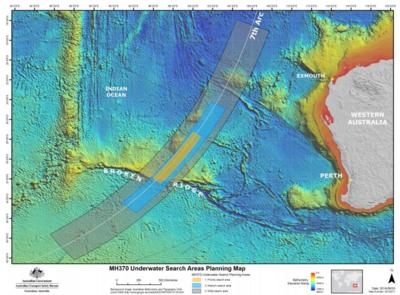Sat, Jun 28, 2014
Information Included On Update On Search Area
In a report released Thursday by the Australian Transport Safety Bureau, the agency says that the most likely scenario for the end of Malaysia Airlines Flight 370 was that all on board succumbed to hypoxia, and that the Boeing 777 traveled on autopilot until its fuel was exhausted and it went down in the Indian Ocean.

In a section titled "End of Flight Scenario", the Bureau writes that "there were multiple redundant communications systems fitted to the aircraft (3 x VHF radios, 2 x HF radios, SATCOM system, 2 x ATC transponders). However, no radio communications were received from the aircraft after 1719.29, 7 hours prior to the last SATCOM handshake at 00:19. Analysis of the SATCOM data also showed that there were probably no large changes to the aircraft’s track after approximately 1915, about 5 hours prior to the last SATCOM handshake.
"Given these observations, the final stages of the unresponsive crew/ hypoxia event type appeared to best fit the available evidence for the final period of MH370’s flight when it was heading in a generally southerly direction:
- loss of radio communications
- long period without any en route manoeuvring of the aircraft
- a steadily maintained cruise altitude
- fuel exhaustion and descent
"This suggested that, for MH370, it was possible that after a long period of flight under autopilot control, fuel exhaustion would occur followed by a loss of control without any control inputs."
The ATSB stresses that this suggestion is made for the sole purpose of assisting to define a search area. The determination of the actual factors involved in the loss of MH370 are the responsibility of the accident investigation authority and not the Search Strategy Working Group (SSWG).
The ATSB said that the next phase of the search will concentrate on an area consisting of about 23,000 square miles extending along an arc for 400 miles in a northeast direction from Broken Ridge. The width of the priority search area is 58 miles. The search is expected to resume in August.
(ATSB Graphic)
More News
Airplane Bounced About 3 Ft Then Touched Back Down And Then, With No Brakes Applied, The Airplane Began Veering To The Left Analysis: The pilot entered the airport traffic pattern >[...]
Aero Linx: British Microlight Aircraft Association (BMAA) The primary focus within all aviation activity is SAFETY. In all aspects of our sport SAFETY must come first, whether it b>[...]
From SnF25 (YouTube Edition): William Wynne Builds Practical Aircraft Engines on the Corvair Platform Seeking an affordable alternative to the traditional aircraft engine options, >[...]
How To Get A Story On Aero-TV News/Feature Programming How do I submit a story idea or lead to Aero-TV? If you would like to submit a story idea or lead, please contact Jim Campbel>[...]
From 2023 (YouTube Edition): Bridge of CiES CiES Inc. is a Bend, Oregon-based designer and manufacturer of modular embedded aircraft systems and sensors. The company’s fuel-l>[...]
 NTSB Final Report: Aviat A1
NTSB Final Report: Aviat A1 ANN's Daily Aero-Linx (07.08.25)
ANN's Daily Aero-Linx (07.08.25) Classic Aero-TV: Fly Corvairs Reliable Engine Alternative
Classic Aero-TV: Fly Corvairs Reliable Engine Alternative ANN FAQ: Contributing To Aero-TV
ANN FAQ: Contributing To Aero-TV Classic Aero-TV: CiES Fuel-Quantity and e-Throttle Systems Praised
Classic Aero-TV: CiES Fuel-Quantity and e-Throttle Systems Praised



